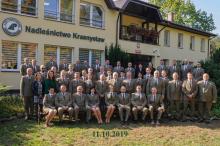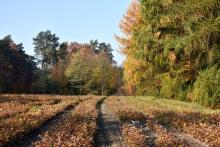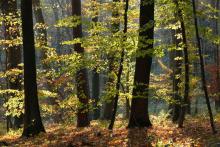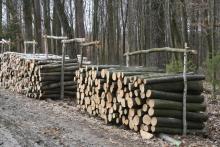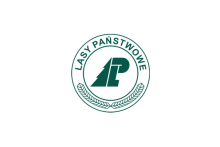 Asset Publisher
Asset Publisher
Polish forests
Poland is in the European lead, while concerning the area of all forests. They cover about 29,2 % of the country territory, and grow within the area of 9,1 million hectares. The overwhelming majority of the forests is state owned, of which almost 7,6 million hectares are managed by the State Forests National Forest Holding..
The number of Polish forest is still growing. The forestation rate of the country has increased from 21 % in 1945 to 29,2 % at the moment. Between 1995 and 2008, the forest area increased by 310 thousand ha. The basis for afforestation works is the "National Programme for Increasing the Forest Cover" (KPZL), assuming an increase of the forestation rate up to 30 % by 2020 and up to 33 % by 2050. Polish forests abound in flora, fauna and fungi. 65 % of the total number of animal species live there.
The forests grow in our country on poor soils, mainly because of the development of the agriculture in previous years. It influences the distribution of the types of the forest sites in Poland. Over 55 % of the forest areas is covered with coniferous forests. In other areas, there are forest sites, mainly the mixed ones. Their small part constitute alder and riparian forests – not more than 3 %.
In the years 1945 – 2011 the area of natural deciduous tree stands within the area of the State Forests National Forest Holding increased from 13 to 28,2 %.
Within the lowlands and uplands the most often occurring tee species is pine. It covers 64,3 % of the forest area of the State Forests National Forest Holding and 57,7 % of private and commune forests. In the mountains the predominant species is European spruce ( in the west) and European spruce with beech (in the east). Domination of pine is the result of carrying on sustainable forest management in the past. Once, the monocultures (crops or cultivations of one species) were the answer to the great demand of industry for wood. Such forests appeared to be quite fragile to climatic factors. They also were often the prey of pests' expansion.
In Polish forests, the share of other tree species, especially deciduous trees have been systematically increasing. The foresters have stepped aside from monocultures – that is why, they try to fit specific species of the forest stand to the natural stand, that would be proper for the given area. Thanks to that, in the years 1945 – 2011, the area of the deciduous tree stands within the lands of the State Forests National Forest Holding increased from 13 to 28,2 %. There occur more and more frequently the following tree species: oaks, ashes, maples, sycamore maples, elms, but also birches, beeches, alders, poplars, hornbeams, aspens, tilias and willows.
Our forests are the most often represented by the forest stands aged 40 to 80 years. The average age of the forest equals 60 years. More and more trees are of big size at the age over 80 years. Since the end of the Second World War, the forests' area has increased up to almost 1,85 million hectares.
Raport o stanie lasów w Polsce 2012
 Asset Publisher
Asset Publisher
DREWNO Z LUBELSKICH LASÓW CENIONE NIE TYLKO W KRAJU
DREWNO Z LUBELSKICH LASÓW CENIONE NIE TYLKO W KRAJU
 Lubelscy leśnicy zadbali o właściwą ekspozycję surowca, fot. Sebastian Jankowski, RDLP w Lublinie
Lubelscy leśnicy zadbali o właściwą ekspozycję surowca, fot. Sebastian Jankowski, RDLP w Lublinie
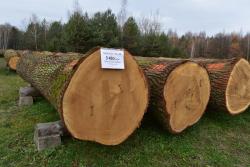 Rekordową cenę wynoszącą 5 450 zł osiągnięto za m3 surowca pochodzącego z Nadleśnictwa Puławy, fot. Sebastian Jankowski, RDLP w Lublinie
Rekordową cenę wynoszącą 5 450 zł osiągnięto za m3 surowca pochodzącego z Nadleśnictwa Puławy, fot. Sebastian Jankowski, RDLP w Lublinie
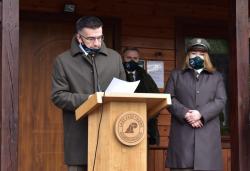 Podsumowania tegorocznej Submisji i odczytania oficjalnych wyników dokonał zastępca dyrektora ds. ekonomicznych, Piotr Mróz, fot. Sebastian Jankowski, RDLP w Lublinie
Podsumowania tegorocznej Submisji i odczytania oficjalnych wyników dokonał zastępca dyrektora ds. ekonomicznych, Piotr Mróz, fot. Sebastian Jankowski, RDLP w Lublinie
Za nami jedenasta edycja Submisji Drewna Cennego „Lubelska Jesień 2020”. Nasi leśnicy zakończyli ją z najwyższą w historii tego wydarzenia ceną za metr sześcienny drewna dębowego.
Rekordową cenę wynoszącą 5 450 zł osiągnięto za m3 surowca pochodzącego z Nadleśnictwa Puławy, a wartość całego losu wyniosła 16 459 zł. Mimo kryzysu gospodarczego spowodowanego sytuacją epidemiczną, podczas tegorocznej Submisji utrzymano wysoką cenę średnią za metr sześcienny oferowanego surowca, a pierwszy raz w historii „Lubelskiej Jesieni” drewno zostało zakupione przez kontrahenta z Włoch, co tylko potwierdziło fakt, że cieszy się ono dużym uznaniem nie tylko na arenie krajowej, lecz także międzynarodowej.
Rozstrzygnięcia jedenastej z kolei Submisji organizowanej przez RDLP w Lublinie dokonano tradycyjnie na placu ekspozycyjnym przy Centrum Edukacyjno-Submisyjnym Nadleśnictwa Krasnystaw. Podsumowania i odczytania oficjalnych wyników dokonał zastępca dyrektora ds. ekonomicznych, Piotr Mróz.
W tym roku do sprzedaży zaoferowano ponad 741 m3 surowca dębowego o ponadprzeciętnych cechach użytkowych. Nabywców znalazło niemal całe proponowane drewno – nie sprzedano tylko dwóch spośród 616 oferowanych losów. Poza rodzimymi gatunkami dębu klienci mogli licytować również sztuki dębu czerwonego.
–O tym, że drewno z lubelskich lasów miało duże wzięcie podczas tegorocznej edycji świadczy najlepiej zapotrzebowanie podmiotów zainteresowanych jego zakupem, które ponad pięciokrotnie przewyższało podaż dębu i przeszło dwukrotnie dębu czerwonego – zaznacza Piotr Mróz.
Ostatecznie średnia cena za metr sześcienny oferowanego surowca wyniosła 3 058 zł i była tylko o 21 zł niższa od najwyższej w historii, którą udało się osiągnąć podczas zeszłorocznej, jubileuszowej edycji.
Najwięcej surowca spośród 12 podmiotów, które spełniły wszystkie kryteria ofertowe zakupił Lubelski Fornir. Ponad 167 m3 drewna trafi do austriackiego kontrahenta, zaś przeszło 101 m3 surowca nabyła firma z Włoch.
–Kolejna edycja „Lubelskiej Jesieni” przeszła do historii i należy ją ocenić jako udaną. Jak co roku, tak i tym razem, największym wyzwaniem było dla nas zapewnienie klientom wyselekcjonowanego, najlepszego i najcenniejszego surowca wybranego z całorocznego planu pozyskania w poszczególnych nadleśnictwach. Osiągnięte ceny pokazują, że udało nam się spełnić ich wysokie wymagania i jest duże zapotrzebowanie na tego typu drewno z lubelskich lasów – podsumowuje dyrektor RDLP w Lublinie, dr inż. Marek Kamola.


 fot. Paweł Fabijański
fot. Paweł Fabijański
 fot. Paweł Fabijański
fot. Paweł Fabijański
 fot. Paweł Fabijański
fot. Paweł Fabijański

